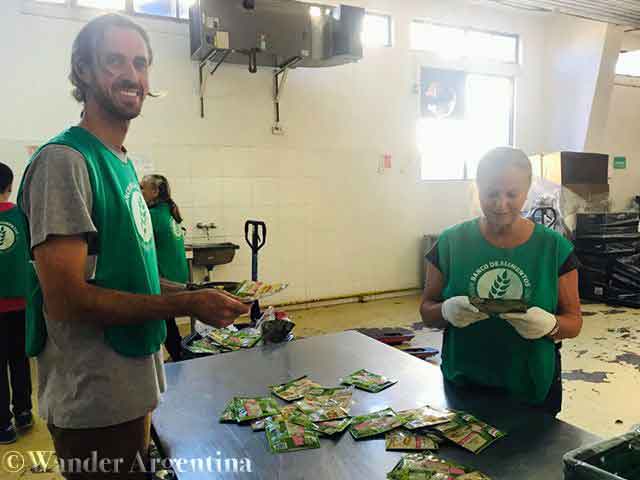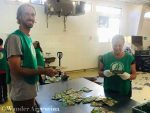 Volunteering with a local organization is a great way to meet new people and get a real understanding of the social and economic conditions of the country.
Volunteering with a local organization is a great way to meet new people and get a real understanding of the social and economic conditions of the country.
The Banco de Alimentos, or the ‘Food Bank’ is an organization that makes it easy for non-natives to do just that. The operation requires volunteer assistance to sort and classify the donations they receive. Volunteers work in three-hour shifts, mornings and afternoons.
Anyone can volunteer as long as they are able to perform basic physical tasks. Minimal commitment is required –volunteers can sign up for as many shifts per week as they like.
The organization is located in San Martin, just outside the Federal Capital area but it is very easily accessible by bus, subte and train from all parts of the city. It usually takes approximately 30 minutes by car and 60 minutes by public transport to get there from most parts of Buenos Aires.
How the Food Bank Began
The idea for the Banco de Alimentos was born in 2000 during a severe socio-economic crisis in Argentina and the organization began operations in 2001.
The organization modelled itself on other food banks already established all over the world. The idea is very simple – the Banco de Alimentos collects donations from manufacturers (there are several in San Martín), supermarkets and other organizations, and sends them to local social institutions and programs (e.g. schools, churches, etc) in various parts of the country. These local institutions provide the goods directly to families and individuals in need.
Donations are primarily food and cooking supplies but can also include other essential items such as cleaning and hygiene products. The team is comprised of full-time employees who manage operations, communications, and transport, who are in turn supported by groups of volunteers working part time.
Since 2001 the Food Bank has delivered over five and half million kilos of food to nearly 144,000 people with the help of nearly 5,000 volunteers pitching in throughout the years.
About 40% of the Banco de Alimentos food donations received need to be sorted and classified before they are fit to send on. This task is conquered by the volunteer teams. No two shifts are the same. One day volunteers could be sorting through boxes of crackers to make sure they’re within their expiry date. On another, they could be sifting through dried soup sachets to confirm they are packaged well enough to survive the journey to the next location. Once classified, items are packaged in crates or cartons and labelled, ready for the journey to their ultimate destination.
At the start of every shift, staff explain the volunteer tasks for that morning or afternoon. There is always an experienced volunteer leading the shift, available to answer any questions.
Shifts at the Food Bank are from 9:30 a.m. until 12:30 p.m. and 1:30 until 4:30 p.m. every weekday. The Friday afternoon shifts end earlier at 4:00 p.m.
Volunteers can sign up for as many shifts as they can handle per week –this could be every day, every week, or every few weeks.
A volunteer coordinator from the organization’s administration team manages the rota and updates their calendar based on volunteer availability.
Long-term Volunteering Opportunities
Longer-term volunteer roles at the Food Bank are also available in administrative work or events for those looking to gain real world employment skills. For those interested, volunteer coordinators from the organisation can provide more information.
Some examples of the more in-depth volunteer activities include:
- Mision Entrega (Delivery Mission): Supporting the organisation by transporting donations to the ultimate beneficiaries (volunteers will be required to have a car)
- Visitador Social (Social visits):Visiting beneficiary organizations and other recipients
- Taller de juguetes (Toy workshop):Aiding with various workshops for children who are beneficiaries of the organisation
While many of the local volunteers have been coming regularly for several years, there are always temporary volunteers around –often travelers, foreign residents (‘expats’) or study-abroad students who are looking to get a more well-rounded experience of Argentina and spend their time doing something socially productive.
A morning or afternoon at the classification warehouse is often like a little journey around the world as people from many countries, backgrounds and of all ages work together to get things done. Most tasks are completed in small groups, making the atmosphere warm and friendly. The radio playing in the background is accompanied by conversations in many languages, depending on the number of non-native volunteers working that shift.
Practice Spanish While Being Useful
Volunteering at the Food Bank does not require an ability to speak Spanish. All the tasks involve basic physical work and are very simple to understand and execute. There is usually always at least one volunteer around who can speak English and translate if required.
For volunteers who do want to learn Spanish or brush up on existing skills, this is a great opportunity to do that – either by joining in on the many conversations or just sitting back and listening.
Working at the Banco de Alimentos requires relatively little time commitment, and offers a great sense of achievement and purpose. The tasks are very tangible. From the very first shift, volunteers can contribute significantly to ensure donations are sent effectively to the ultimate beneficiaries of the organization.
Volunteering at the Food bank is a great way to meet new people and expand one’s knowledge of the real issues faced by Argentinians all over the country. A few hours of a volunteer’s time can enrich their experience in Argentina as well as support the organization to move closer to its goal of eradicating hunger across Argentina.
—by Vidha Jain
How to sign up:
For more information or to sign up, fill out this form here: https://www.bancodealimentos.org.ar/se-voluntario-formulario/or email rrhh@bancodealimentos.org.ar.
A member of staff will get in touch to explain the next steps or to answer any questions.
Banco de Alimentos
Luis María Drago 5530, San Martín,
Provincia de Buenos Aires (1650), Argentina
Directions:
Pedestrian Entrance: Luis María Drago 5530, San Martin
Parking Entrance: Alexander Fleming 2050, San Martin
The Food Bank can be accessed by buses 93, 333, 41, 130, 343, 127, 140, 330, 67. The closest train stations are Munro, Olivos, Mitre.
Like this article? Please show your love and share it on social media! Also check out other volunteer opportunities on this website, or learn about opportunities to volunteer with Wander Argentina!


